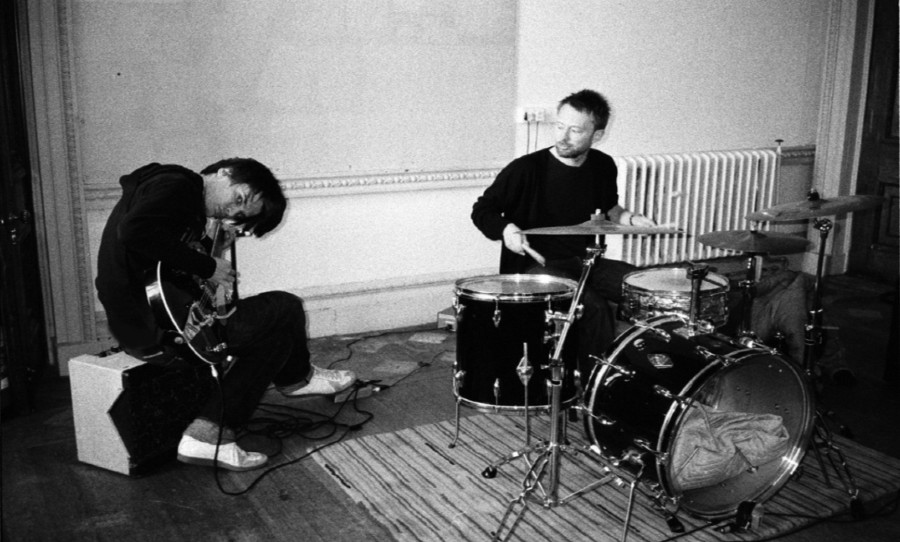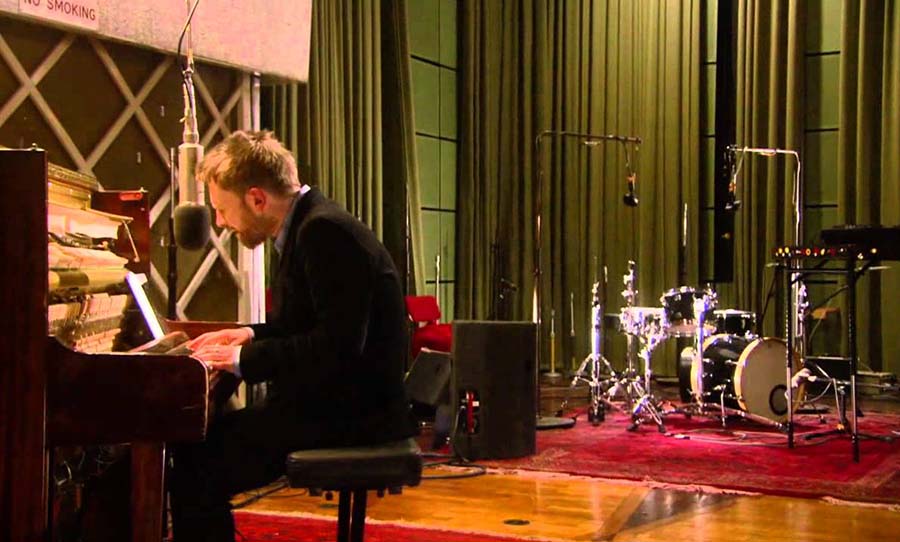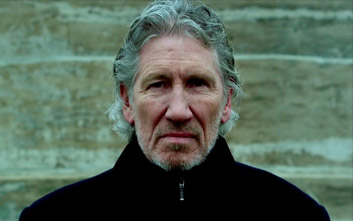Remembered by the band as the album that almost killed them, we dive into the precarious making of Radiohead’s In Rainbows.
“The internet is not the fucking universe.”
This is something you have surely heard from you’re grandfather at least once or twice. (A few years back I could have written ‘father’ but let’s face it, the babyboomers are just as caught up in this virtual mess as anyone else.)
However, surprisingly enough, this particular quote was ripped from none other than the jittery frontman who has made singing about neurosis in an unfaltering falsetto cool. Thom Yorke.

The quip came in response to a question about an eventual physical release for their 2007 effort, In Rainbows, which was initially released sans-label, to throngs of adoring (and obsessed) fans on the internet, under an innovative pay-what-you-want model. The quote, coming from a member of Radiohead, is quite ironic considering that the band’s entire existence is plastered across the internet, with zealous fans updating forums in real-time to map the band’s every movement.
Inspired by the crushing ten-weeks-premature leak of their previous album, 2003’s Hail to the Thief, Radiohead decided they would release their next album on their own terms. It also helped that the band were technically unemployed; without a label following the end of their 12-year contract with Parlophone/EMI. This also played a role in them wanting to get the music to the public in the fastest way possible by giving it away (basically) for free on the internet. A method up-and-coming bands around the world are painfully familiar with today.
Record distribution gimmicks aside (it’s still a matter of debate about whether or not the release was a money-making scheme or a genuine artistic experiment), the sublimity of In Rainbows continues to shine a decade after its release, though some people still seem to get caught up in the economics of it all.
The album was restrained, with every member finding their own unique place in the mix, each with their very own glowing moments. A far cry from the bleeps and bloops of Kid A (2000) and Amnesiac (2001), each of the quintet is easily distinguishable as the songs appear stripped back and free from the heavy overdubbing that characterised the aforementioned turn of the millennium albums.
Comprised of songs spanning their entire career, In Rainbows is a reflective album that manages to sound entirely new at the same time. Arguably their most palatable offering, the record paid homage to the guitar drive of their 1990s LPs, The Bends and OK Computer (see Bodysnatchers) though devoid of the same anthemic character. And while the electro-tinkering that shaped Kid A and Amnesiac took a back seat on a majority of the album, the opening drum beat of opener 15 Step (a 5/4 time signature masterpiece in its own right) is clearly flavoured by Jonny Greenwood’s obsession with programming.
Though the album harkens to Hail to the Thief, which combined the approaches of previous work, weaving together programmed synthesised sounds with the guitar-laden soundscapes resulting in a far livelier atmosphere, In Rainbows reminds the listener that the band doesn’t need synthesised sound or computers to express themselves (though they are there–how could they not be? It’s Radiohead, need I remind you). It showed once again that they are five incredible artists whose music can stand tall as bare-bones as can be (see Jigsaw Falling into Place).
A Long Gestation Period
In Rainbows, by some stretch of the imagination, is a debut album. After Hail to the Thief’s release and respective tour, the band took almost a year off. They were exhausted, and the album’s rushed recording session (a complete reversal to their painfully drawn out two-year recording process for Kid A and Amnesiac) was enough to make the boys second guess whether this was actually what they wanted to do with their adult lives. Without a record company hounding them for more material, the band, already well into their 30s, were looking for a life beyond making music.
Enter ‘the joys of parenthood.’
2005 saw the return of Radiohead, though not so much to the public eye, and not to much avail. The band rehearsed together and attempted to write new material, but with little success. The process was painstakingly slow and unproductive. The lack of a deadline or distribution outlet meant that nothing actually had to be finished. Professionally, the band had no reason to be together and fans began to wonder if Radiohead had thrown in the towel.
After six weeks of rehearsal and a dead-end recording session with Mark “Spike” Stent (a legendary producer who has worked with the likes of Madonna, U2, and Frank Ocean), the band decided to go on tour and trial some songs, essentially offering audiences a tasting plate. They knew they had some great material; the difficultly lay in having five of the most pedantic musicians in the industry agree on how to put it all to tape.
The 2006 tour was a liberating time for the band, free from the shackles of mixing desks and headphones. The band sampled most of the tracks that would eventually wind up on the album. However, it is worth noting that some songs were brought back to life after being written years before, and even played live well before the ‘trial and error’ tour of 2006. Nude had its origins in the 1990s, masqueraded in a clock of alter egos/alternate song titles; Weird Fishes/Arpeggi ‘hails’ back to the Hail to the Thief sessions; Reckoner existed virtually for years, though in a much heavier incarnation (thanks, Youtube).
Exploring Other Outlets
Thematically speaking, the swiftly approaching middle-aged duties of parenthood that had encapsulated the lives of band members greatly affected the songwriting on In Rainbows, trading in the politically charged agenda of Hail to the Thief for a more reflective and personal lyrical character that centres more on immediate relationships rather than global phenomena.
While one of the more warm and inviting moments in Radiohead’s catalogue, In Rainbows would not be a Radiohead album without the following quote from Thom Yorke: “It was much more about the fucking panic of realising you’re going to die! And that any time soon [I could] possibly [have] a heart attack when I next go for a run.”
Professionally speaking, band members’ creative outlets also impacted the album’s soundscape. Guitarist/keyboardist/composer/programmer, Jonny Greenwood had kept busy scoring films such as Bodysong (2003) and There Will Be Blood (2007). His dabbles shine through the album, with orchestral arrangements featuring prominently on Nude, Faust Arp, All I Need, to name a few.
In 2006, Thom Yorke finally got around to releasing a solo album – the melodic, electronic The Eraser – comprising ideas and sounds he had been kicking around for years. Yet In Rainbows is noticeably stripped back, free from the shimmering electronic chaos that characterised Kid A and Amnesiac. Presumably, The Eraser channelled a lot of the electric energy away from Radiohead’s sound, allowing them to focus more on their organic chemistry as a band, much like they had when they met decades before as schoolboys.
Nigel (back) in the Driver’s Seat
The band’s recording attempts with Stent may have been more frustrating than productive, but they certainly cleared up one thing: Nigel Godrich is the Radiohead producer.
Often dubbed the 6th member of the band – a modern-day George Martin – Godrich had produced every album since their breakthrough 1995 release, The Bends (note he did not produce their collectively-regarded-as-abysmal [band members included] debut Pablo Honey). And Like Grandpa always says, “If it ain’t broke, don’t fix it”.
Back in command, Godrich gave the band a much needed “walloping kick up the arse”. Upon returning to his role as a father-figure, Godrich took the boys on a little excursion to a decrepit estate called Tottenham House, about 40 minutes outside of Oxford, England (the band’s stomping grounds), to record the album.
The building’s lack of structural integrity ironically mirrored that of the band–while seemingly falling apart with holes in the ceiling, the larger than life building (read ‘band’) just needed a little TLC.
The cavernous mansion of 100-plus rooms offered an endless source of natural reverb for the album. Space also allowed ideas to flow freely, and many of the tracks were laid down quickly; for example, Bodysnatchers, which was recorded during a 12-hour hyperactive mania, despite Yorke feeling considerably ill. Thankfully, the vocals for the track remained largely untouched in post-production, preserving this fantastically frenzied feel.
Godrich is also a massive gear nerd. One of the mixing desks used on the album was a 24-channel Audiotronix console that he got from a studio in L.A, and was allegedly used on a bunch of Motown records. For Yorke’s crunchy rhythm tone on Bodysnatchers, Godrich his guitar direct into the console, harnessing its warm, natural distortion and gifting the album with its heaviest number (and one of its most memorable moments).
Close The The Edge
When reflecting on the legacy of In Rainbows a decade down the track, the consensus seems to be that it near destroyed the band as we know it. Ed O’Brian has been quoted saying that recording the album “almost killed” them, and Godrich admitted to Rolling Stone in 2012 that it “was very difficult in a way [they] had never experienced before.” Thom Yorke, ever candid and self-deprecating, summed up the recording process with four words: “We think too much”.
No song better exemplifies the near breaking point the band teetered on while recording the album than the tender closer, Videotape.
To start, the track is bare, simple, and, in a way, mundane. However, upon the entrance of Phil Selway’s marching drum beat, it is revealed that the piano’s four opening chords are actually syncopated, falling right behind the beat. The band reportedly spent hours arguing where the ‘one’ actually was.
The painstaking process resulted in a tone eerily similar to the haunting, twisted Kid A closer, Motion Picture Soundtrack. But where that song falls into a dreamlike ending close, with cascading harp strings, Videotape breaks apart into nothing.
Phil’s march gives way to an almost drum machine-like hi-hat rhythm, while Jonny introduces a very subtle synth. But as these elements depart, it is Yorke’s piano that closes the album, not really resolving anything so much as pulling everything back to the centre. A grounding of sorts.
The syncopated piano not only closes the album but also underscores the essence of In Rainbows. Despite success having rocketed them to the moon and back, the band was able to return from the brink of having lost all momentum by simply grounding their sound and stripping back to what they are at their core: five madly talented musicians arguing about where the first beat of a song is.



